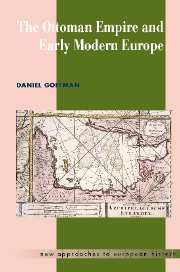Book contents
- Frontmatter
- Contents
- List of illustrations
- List of maps
- Preface
- Acknowledgements
- Note on usage
- Chronological table of events
- The Ottoman House through 1687
- 1 Introduction: Ottomancentrism and the West
- Part 1 State and society in the Ottoman world
- Kubad's formative years
- 2 Fabricating the Ottoman state
- Kubad in Istanbul
- 3 A seasoned polity
- Kubad at the Sublime Porte
- 4 Factionalism and insurrection
- Part 2 The Ottoman Empire in the Mediterranean and European worlds
- Glossary
- Suggestions for further reading
- Index
- NEW APPROACHES TO EUROPEAN HISTORY
3 - A seasoned polity
from Part 1 - State and society in the Ottoman world
Published online by Cambridge University Press: 05 June 2012
- Frontmatter
- Contents
- List of illustrations
- List of maps
- Preface
- Acknowledgements
- Note on usage
- Chronological table of events
- The Ottoman House through 1687
- 1 Introduction: Ottomancentrism and the West
- Part 1 State and society in the Ottoman world
- Kubad's formative years
- 2 Fabricating the Ottoman state
- Kubad in Istanbul
- 3 A seasoned polity
- Kubad at the Sublime Porte
- 4 Factionalism and insurrection
- Part 2 The Ottoman Empire in the Mediterranean and European worlds
- Glossary
- Suggestions for further reading
- Index
- NEW APPROACHES TO EUROPEAN HISTORY
Summary
The government of the Ottomans is completely despotic: for the Grand Turk is so much the master of all things contained within the bounds of his dominions, that the inhabitants account themselves his slaves, not his subjects; no man is master of himself, or of the house in which he lives, or of the fields he tills, except certain families of Constantinople whom Mohamet II has chosen and privileged; and there is no personage so great that he stands secure in his life or in his estate unless it so please the Grand Signor. He maintains such absolute power in two ways: by disowning his subjects and by turning everything over to the Renegados, whom he has taken in their childhood as tithes from his states.
In the fourteenth and early fifteenth centuries the Ottoman polity was in the process of invention, and was thus quite malleable. Its beginnings are shrouded in myth and we probably never will be certain of its foundations. Nevertheless, as we have seen, the early Ottoman state did seem endowed with the ability to shrug off those props that appeared not to work, to knead out the flaws of others, and to create new formations as needed. This facility helped the state survive crises of succession, jealous rivals, civil wars, even defeat, dismemberment, and other vicissitudes of fortune.
In the years after the reconstitution of the Ottoman state in 1413 the principal constructions of Ottoman government and society began to crystallize.
- Type
- Chapter
- Information
- The Ottoman Empire and Early Modern Europe , pp. 59 - 92Publisher: Cambridge University PressPrint publication year: 2002

